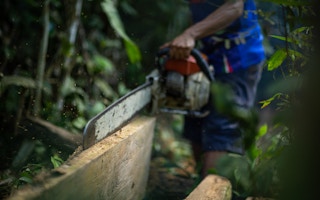Tropical forests continue to be felled or burned at an alarming rate despite pledges made at UN climate summits to eliminate the problem by 2030, global analysis suggests.
The biggest losses occur in Brazil, the Democratic Republic of Congo (DRC), and Bolivia – home to the world’s largest and most ecologically significant tropical rainforests, according to the US University of Maryland’s 2022 Tree Cover Loss Data, presented by the World Resources Institute’s (WRI) Global Forest Watch.
The new data shows that in 2022 the tropics lost 4.1 million hectares (10.1 million acres) of primary rainforest – an area roughly the size of Switzerland – at a rate equivalent to 11 football pitches a minute.
This represents a ten per cent increase from 2021 and resulted in 2.7 gigatonnes of carbon dioxide emissions – equivalent to the annual fossil fuel emissions of India, according to the analysis.
Forests are home to more than 80 per cent of terrestrial species of animals, plants and insects and provide shelter, jobs and security for the communities who inhabit them, says the UN. And forest loss and damage is estimated to cause around ten per cent of global warming.
At the UN’s COP26 climate conference in Glasgow in 2021, 145 countries committed to halt and reverse deforestation by 2030, while at last November’s COP27 in Egypt, 27 countries banded together to accelerate action towards these pledges.
“
Some drivers are directly linked to what we can call legal deforestation… linked to governmental policies and projects that have supported the growth of agriculture, selective timber extraction, and mining. Despite the countless meetings and conferences, the general trend is more loss and not the contrary.
Marcos Pedlowski, associate professor, State University of Northern Rio de Janeiro
However, the WRI says the goals will not be met on the current trajectory, with declines in forest loss failing to materialise.
“Globally, we are far off track and trending in the wrong direction when it comes to reducing deforestation,” Rod Taylor, WRI’s global director for forests, told a media briefing on 21 June.
“Our analysis shows that global deforestation in 2022 was over 1 million hectares above the level needed to be on track for zero deforestation by 2030,” he added.
Loss of forests is seen as a key issue in fighting climate change, as carbon is removed from the air by living forests and emitted when trees are felled or degraded.
In Brazil, the rate of primary forest loss rose 15 per cent from 2021 to 2022, mostly in the Amazon. The country’s overall loss accounted for more than 40 per cent of the global total.
Fires and logging
Marcos Pedlowski an associate professor at Brazil’s State University of Northern Rio de Janeiro, told Scidev.Net that deforestation – the total removal of trees – is only part of the problem.
“Although the numbers may be seen as dramatic, they are not telling the whole story because there is another concurrent element of land cover change, which is forest degradation,” he explained.
Areas being degraded, for example by fires and selective logging, are even more common than those being deforested, said Pedlowski.
“As a result, there are many more reasons for concern in relation to the impoverishment of forested areas,” he added.
Regarding Brazil, home to the largest area of tropical forest on the planet, Pedlowski pointed to a combination of drivers fuelling both deforestation and degradation.
“Some drivers are directly linked to what we can call legal deforestation… linked to governmental policies and projects that have supported the growth of agriculture, selective timber extraction, and mining,” he said.
Pedlowski believes these trends expose the weaknesses of multilateral institutions and conferences when it comes to controlling forest change.
“Despite the countless meetings and conferences, the general trend is more loss and not the contrary,” he added.
“This situation is further complicated by the complex global economic situation which was aggravated by the Covid pandemic and the war in Ukraine and its effect on food production.
“Unless the global grain, timber and meat traders take seriously their responsibilities regarding the traceability of their products and avoid buying commodities produced in illegally deforested areas, I do not see how to achieve any positive change,” he added.
Forest preservation
On the positive side, Indonesia has reduced its primary forest loss more than any other country in recent years, followed by Malaysia, according to Global Forest Watch.
Government interventions and corporate and community programmes have enabled the two countries to keep their rates of tropical primary forest loss near record-low levels.
Analysts put Indonesia’s success down to policies such as its logging moratorium, fire monitoring, and peat restoration, as well as effective corporate actions.
M. Faiz Syuaib, an agricultural engineer and director of research, technology, and community services at Indonesia’s Ministry of Education, Culture, Research and Technology, said the Indonesian government had been actively trying to preserve the country’s forests for more than a decade.
Timber extraction is limited to state-controlled companies and new trees must be planted to replace those felled, he told SciDev.Net.
In areas vulnerable to wildfires, said Syuaib, water-filled moats are being built to stop fires from spreading.
This article was originally published on SciDev.Net. Read the original article.










